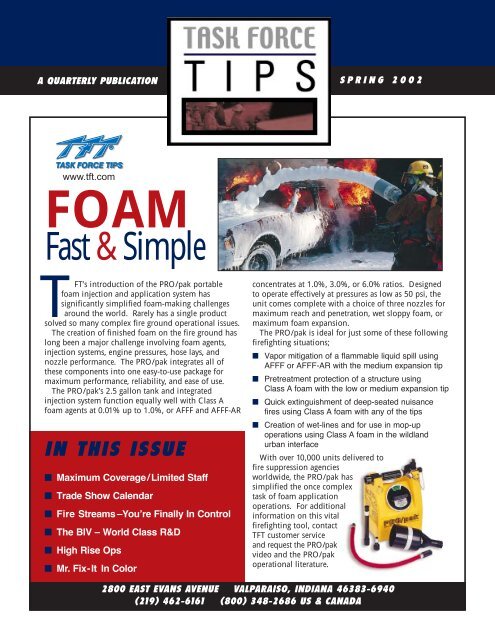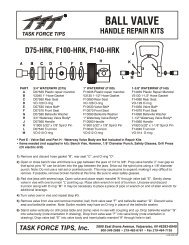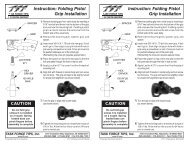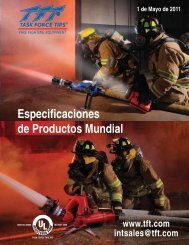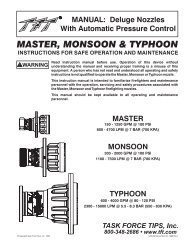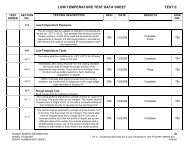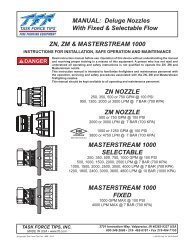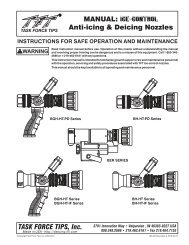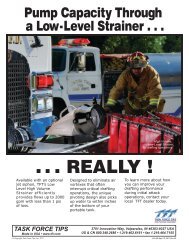You also want an ePaper? Increase the reach of your titles
YUMPU automatically turns print PDFs into web optimized ePapers that Google loves.
A QUARTERLY PUBLICATION SPRING 2002<br />
www.tft.com<br />
FOAM<br />
Fast & Simple<br />
TFT’s introduction of the PRO/pak portable<br />
foam injection and application system has<br />
significantly simplified foam-making challenges<br />
around the world. Rarely has a single product<br />
solved so many complex fire ground operational issues.<br />
The creation of finished foam on the fire ground has<br />
long been a major challenge involving foam agents,<br />
injection systems, engine pressures, hose lays, and<br />
nozzle performance. The PRO/pak integrates all of<br />
these components into one easy-to-use package for<br />
maximum performance, reliability, and ease of use.<br />
The PRO/pak’s 2.5 gallon tank and integrated<br />
injection system function equally well with Class A<br />
foam agents at 0.01% up to 1.0%, or AFFF and AFFF-AR<br />
IN THIS ISSUE<br />
■ Maximum Coverage / Limited Staff<br />
■ Trade Show Calendar<br />
■ Fire Streams ÐYouÕre Finally In Control<br />
■ The BIV Ð World Class R&D<br />
■ High Rise Ops<br />
■ Mr. Fix-It In Color<br />
concentrates at 1.0%, 3.0%, or 6.0% ratios. Designed<br />
to operate effectively at pressures as low as 50 psi, the<br />
unit comes complete with a choice of three nozzles for<br />
maximum reach and penetration, wet sloppy foam, or<br />
maximum foam expansion.<br />
The PRO/pak is ideal for just some of these following<br />
firefighting situations;<br />
■ Vapor mitigation of a flammable liquid spill using<br />
AFFF or AFFF-AR with the medium expansion tip<br />
■ Pretreatment protection of a structure using<br />
Class A foam with the low or medium expansion tip<br />
■ Quick extinguishment of deep-seated nuisance<br />
fires using Class A foam with any of the tips<br />
■ Creation of wet-lines and for use in mop-up<br />
operations using Class A foam in the wildland<br />
urban interface<br />
With over 10,000 units delivered to<br />
fire suppression agencies<br />
worldwide, the PRO/pak has<br />
simplified the once complex<br />
task of foam application<br />
operations. For additional<br />
information on this vital<br />
firefighting tool, contact<br />
TFT customer service<br />
and request the PRO/pak<br />
video and the PRO/pak<br />
operational literature.<br />
2800 EAST EVANS AVENUE VALPARAISO, INDIANA 46383-6940<br />
(219) 462-6161 (800) 348-2686 US & CANADA
WELCOME<br />
Recently, you may have noted in some trade journal<br />
advertising or on its web site that Akron Brass has discontinued<br />
the production of its automatic series of handline nozzles. Since<br />
many of our readers use TFT automatics every day, I felt some<br />
simple straightforward comments were necessary.<br />
It is true that the Akron Automatics have not been nearly as<br />
successful in the marketplace as those manufactured by Elkhart<br />
and <strong>Task</strong> <strong>Force</strong> <strong>Tips</strong>. It is also true that it’s Akron's right to pull<br />
the series off the market anytime it chooses. This, of course, is a<br />
business decision based on profit and loss. But, in the course of<br />
making this business decision, and in an effort to re-market and<br />
re-package much older nozzle technology, a tremendous<br />
disservice is being done to the 20,000 plus fire departments in<br />
this country that stake their lives every day on the performance<br />
of automatic nozzles.<br />
Akron Brass’s recent announcement that it has discontinued<br />
the manufacture of automatic nozzles because the technology<br />
has been “surpassed” by fixed and selectable gallonage nozzles,<br />
not only is a gross misstatement of the facts; it is revisionist<br />
history to the MAX!!<br />
All nozzles squeeze off the flow to achieve pressure. In fact,<br />
the only purpose of a nozzle is to squeeze off the flow so that<br />
pressure (velocity) is developed to project the stream (mass).<br />
The inference, in recent releases, that this is solely the function<br />
of an automatic nozzle is inaccurate and somewhat misleading.<br />
The only thing different about an automatic (Elkhart’s, TFT’s, or<br />
the discontinued Akron’s) is that they size the orifice through a<br />
spring and/or hydraulic balance automatically throughout a<br />
range of flows and pressures.<br />
As a TFT user, you certainly have come to realize the benefits<br />
an automatic nozzle can provide in fire streams management<br />
operations. And, if you are thoroughly familiar with the product<br />
line, you will also realize that automatic nozzles come in many<br />
operating pressure choices (55 psi, 75 psi, 100 psi) to meet<br />
different fire department requirements, as well as exceeding the<br />
exacting standards of the NFPA 1964 Standard (1998 edition).<br />
We will continue our commitment to work with departments<br />
to help determine their fire streams management goals. We feel<br />
education is still the best selling tool we have. Meeting and<br />
exceeding your needs and expectations is our primary task.<br />
Whether you choose, fixed, selectable, or automatic nozzles, <strong>Task</strong><br />
<strong>Force</strong> <strong>Tips</strong>, Inc. will be here offering over 400 models of high<br />
performance fire streams management equipment. Please don’t<br />
be misled by marketing hype.<br />
Regards,<br />
UPCOMING<br />
SHOWS<br />
Industrial Fire World<br />
April 1-4, Houston, TX<br />
<strong>Task</strong> <strong>Force</strong> <strong>Tips</strong>, Inc. will be introducing the latest in LDH<br />
hardware and new Fire Streams Management equipment.<br />
Visit with Paul Neely, TFTÕs Industrial Products Manager,<br />
and attend his ÒFire Streams to the MAXÓ program.<br />
FDIC West<br />
May 1-3, Sacramento, CA<br />
Stop by and visit with Dave Burns, Southwestern<br />
Regional Manager, and have him show you the newest<br />
Large Diameter Hose Hardware. Dave will be exhibiting<br />
with our distribution partner L.N. Curtis and Sons<br />
at this show.<br />
Emergency Response Training School<br />
May 6-9, Beaumont, TX<br />
Paul Neely, TFTÕs Industrial Products Manager, will be in<br />
attendance for this important training program.<br />
Pennsylvania Fire Expo<br />
May 17-19, Harrisburg, PA<br />
Jim Cottrell and Chris Carson of Cottrell Associates and<br />
several TFT representatives will be attending the Òlargest<br />
selling showÓ in the fire industry. Come see the new<br />
METRO II nozzle.<br />
NFPA Conference<br />
May 20-22, Minneapolis, MN<br />
Rod Carringer and Arthur Cuenca will be in attendance<br />
for this important conference and standard making<br />
program. Stop by the booth to see the latest in NFPA<br />
compliant nozzles.<br />
New York Chiefs FIRE 2002<br />
June 6-8, Syracuse, NY<br />
Cottrell Associates as well as TFT factory<br />
representatives will be in attendance with several field<br />
training apparatus as well as an extensive inside<br />
display booth.<br />
Iowa State Fire School<br />
June 13-16, Ames, IA<br />
Visit with Ken Kendrick, TFTÕs North Central Regional<br />
Manager, and take a look at all of the goodies on his new<br />
training and demonstration vehicle.<br />
Illinois Fire Districts<br />
June 20-22, Springfield, IL<br />
Stop by and see Andy Plofkin, TFTÕs Midwestern<br />
Regional Manager, and review the new Large Diameter<br />
Hose Hardware and the new METRO II nozzle.<br />
Stewart McMillan<br />
President
I N D U S T R I A L<br />
Blitzfire OSC<br />
MAXIMUM COVERAGE/LIMITED STAFF<br />
New Automatic<br />
Oscillation Feature<br />
ELEVATION<br />
PERFORMANCE<br />
OSCILLATION<br />
PERFORMANCE<br />
The Blitzfire OSC is a highly maneuverable initial<br />
attack monitor with TFT’s exclusive nozzle<br />
oscillation feature. The Blitzfire OSC’s low elevation<br />
angle makes it suitable for aggressive interior attack<br />
or exterior defensive operations when cooling or exposure<br />
protection is necessary. It can go anywhere a handline goes<br />
while delivering far more water with limited staff.<br />
If the Blitzfire OSC starts to slide or lift, the SAFETY<br />
SHUT-OFF VALVE automatically shuts off the flow of water.<br />
This safety feature reduces the risk of injury from an<br />
out-of-control appliance. The shut-off slows near stroke end<br />
to eliminate potential water hammer.<br />
To reset the flow, simply re-open the valve to any of six<br />
detent flow positions with the turbulence-free slide valve.<br />
The Blitzfire OSC’s unique water turbine design drives the<br />
oscillating unit in a selectable 20-, 30-, or 40-degree sweeping<br />
motion. The oscillating mechanism can be easily disengaged<br />
for manual operation. A unique up/down pivot on the hose<br />
inlet allows the monitor to have stability even on porches,<br />
stair landings, or the like. An anchor strap is included for safe<br />
operation on slick surfaces like marble floors. The main body<br />
is hardcoat-anodized aluminum with a TFT powder coat finish<br />
inside and out.<br />
When cooling of processing or operating units is necessary,<br />
yet limited staffing will not allow the use of manned<br />
equipment, the Blitzfire OSC can provide up to 500 gpm in an<br />
unmanned operation. For hazardous locations, the oscillating<br />
feature will allow continued cooling or firefighting operations<br />
while fire brigade members remain safe. The Blitzfire OSC is<br />
the perfect appliance for high-flow, unattended operations or<br />
for an aggressive interior attack.<br />
For additional information, contact TFT Customer<br />
Service and request the new Blitzfire OSC<br />
videotape and corresponding operational literature.
The challenge of redesigning<br />
the traditional fire apparatus<br />
piston/gate intake valve has been<br />
a nearly two-year project for<br />
TFT’s LDH hardware design and<br />
manufacturing team.<br />
Thousands of hours have been<br />
devoted to understanding the<br />
problems identified with current<br />
competitive models and finding<br />
unique solutions that address<br />
these critical operational issues.<br />
Here are some of the key<br />
findings that were determined by<br />
end-user focus groups, internal<br />
research teams, and TFT’s field<br />
managers as being key to the<br />
design and development of a<br />
new style intake valve.<br />
CREATING THE NEW BIV (BALL INTAKE VALVE)<br />
World Class Research<br />
& Development
Corrosion in Piston Valves<br />
ISSUE #1<br />
CORROSION<br />
Even on relatively new equipment,<br />
galvanic corrosion and corrosion from<br />
aggressive mineral-laden water continue<br />
to render many valves unusable after a<br />
short period of time.<br />
ISSUE #2<br />
LACK OF INLET FUNCTIONALITY<br />
AND FLEXIBILITY<br />
Using the typical fixed elbow design for<br />
an inlet, nearly all models of intake<br />
valves currently on the market can cause<br />
kinking of supply hose as it leads<br />
to the pump.<br />
ISSUE #3<br />
FLOW INEFFICIENCY<br />
With apparatus pump capacities moving<br />
more commonly towards 1500 gpm and<br />
2000 gpm, inefficient intake valves create<br />
additional friction loss and rob pumps of<br />
their peak performance.<br />
With this valuable input, TFT’s<br />
research and development group went to<br />
work designing the next generation of<br />
pump intake valves. Using information<br />
gained from the purchase of Jaffrey Fire<br />
Protection’s LDH hardware line and<br />
incorporating the proven coatings<br />
technology used on other TFT products,<br />
the BIV is truly an evolution in the LDH<br />
appliance business.<br />
TACKLING THE CORROSION ISSUE<br />
Two separate parallel initiatives took<br />
place to solve the long-standing corrosion<br />
issues that the team identified:<br />
1. Provide a coating process that would<br />
protect the lightweight aluminum<br />
castings from the corrosive effects of<br />
mineral-laden water that may lay in<br />
the valves for months<br />
2. Break the electrical conductivity<br />
within the pump and plumbing<br />
system that leads to galvanic<br />
corrosion on the attached valve.<br />
The team’s final decision for the<br />
protective coating of the aluminum<br />
castings consists of a three-step process<br />
and is designed to provide maximum<br />
corrosion-resistance under rugged<br />
fireground conditions.<br />
Since a raw aluminum casting is very<br />
porous, the first challenge is to eliminate<br />
that porosity and fill in the small cavities<br />
that can trap and hold moisture. This is<br />
accomplished with a process that<br />
impregnates a polymer material into the<br />
casting while under a vacuum.<br />
Next, the casting receives a<br />
hardcoat/anodizing treatment that<br />
chemically converts the outer shell to<br />
aluminum oxide. This is the same process<br />
TFT has used successfully for years on all<br />
handheld nozzles and accessories.<br />
Finally, the casting has a polyester<br />
powder coating electrostatically bonded<br />
inside and out. This powder coat process<br />
is common not only in TFT equipment,<br />
but is also used widely in the automotive<br />
industry, home appliances, and for<br />
outdoor furniture.<br />
Nylon/Polymer<br />
Ring<br />
To break the electrical conductivity that<br />
exists between the dissimilar metals of<br />
the pump and valve and eliminate the<br />
associated galvanic corrosion, TFT<br />
engineers took a bold step and removed<br />
the stainless steel ball bearings in the<br />
BIV’s coupling. A nylon/polymer ring<br />
was chosen to replace the bearings and<br />
short circuit the electrical conductivity<br />
between the pump and the valve. This<br />
patent pending concept also allows<br />
smooth coupling operation under all<br />
conditions and is designed to meet and<br />
exceed the new NFPA #1965 900 psi<br />
hydrostatic strength test.<br />
MAKING THE VALVE<br />
MORE USER FRIENDLY<br />
Since all current intake valves that include<br />
an elbow are rigid, hose kinking or cross<br />
threading often occurs when the supply<br />
hose comes to the pump panel from<br />
different directions. This is especially<br />
true for those fire departments that use<br />
hard suction hose while drafting from<br />
porta-tanks and dry hydrants. TFT’s<br />
solution: allow the inlet elbow to swivel<br />
360-degrees. By permitting the elbow to<br />
swivel, a supply hose or hard suction<br />
hose can come from any direction, be<br />
easily connected, and eliminate the<br />
possibility of flow-restricting kinks or<br />
cross threading. The inlet swivel has<br />
eight positive detent positions, and a pull<br />
pin that will allow full-time 360-degree<br />
swiveling, or will lock the elbow into any<br />
of the detent positions. This unique<br />
swiveling feature, a newly designed<br />
50-250 psi pressure relief valve, and the<br />
visual valve position indicator has<br />
gathered “resounding thumbs up”<br />
comments from firefighters at over 20<br />
field test sites around the country.<br />
FLOW EFFICIENCY AND THE OLD<br />
JAFFREY DESIGN<br />
TFT’s stainless steel split-ball valve design,<br />
incorporated in the new BIV, was recently<br />
granted a US patent. This design, used<br />
in older Jaffrey intake valves, is<br />
especially suited for maximum flows<br />
with minimal friction loss during<br />
either a pressurized or drafting<br />
operation. Unlike competitive<br />
piston-style intake valves, the water<br />
path through the BIV has no<br />
obstacles or bends to rob your pump’s<br />
flow performance. With only<br />
limited friction loss at 2000 gpm<br />
flow, the straight through flow<br />
of the new BIV offers the highest<br />
performance-to-weight ratio of any<br />
intake valve on the market today. The<br />
TFT design team capitalized and<br />
improved on years of field feedback<br />
from hundreds of Jaffrey Fire<br />
Protection customers. It is this<br />
partnership, in development with our<br />
customers, that supports TFT’s passion<br />
for producing the finest in fire streams<br />
management equipment.
YOU'RE FINALLY IN CONTROL !<br />
SLIDE VALVE<br />
SLIDE VALVE<br />
Gated Half Way<br />
BALL VALVE<br />
Gated Half Way<br />
BALL VALVE<br />
SLIDE VALVE<br />
Gated Half Way<br />
SLIDE VALVE<br />
Full<br />
BALL VALVE<br />
Gated Half Way<br />
BALL VALVE<br />
Full<br />
Since 1986, when our<br />
engineering team<br />
designed, developed, and<br />
patented the slide valve,<br />
the vast majority of<br />
automatic nozzles delivered by<br />
<strong>Task</strong> <strong>Force</strong> <strong>Tips</strong> has included<br />
this critical flow control feature.<br />
Often, long time TFT<br />
departments aren’t even aware<br />
of this feature when they<br />
continue to teach the rookies<br />
“use the nozzle all the way<br />
open or all the way closed,<br />
but don’t gate it!”<br />
Very simply stated, the use of<br />
the slide valve in combination<br />
with an integrated automatic<br />
pressure control mechanism<br />
allows a firefighter the ability to<br />
gate down a nozzle without<br />
loosing stream quality or<br />
impact. Unlike the slide valve,<br />
a ball or spilt-ball design<br />
creates turbulence in the nozzle<br />
when gated. This leads to:<br />
1. a very poor quality stream, and<br />
2. instructors teaching the rookies<br />
to not gate the nozzle.<br />
SLIDE VALVE<br />
CONSIDERATIONS<br />
■ Stainless Steel design eliminates<br />
“valve seat” replacements<br />
■ Designed to be gated<br />
for flow control<br />
■ Will not bind or tighten with age<br />
■ Will not tighten under<br />
high-pressure operations<br />
BALL VALVE<br />
CONSIDERATIONS<br />
■ Designed to be used in fully<br />
open or fully closed position<br />
■ May tighten up with age<br />
and need seats replaced<br />
■ More difficult to open<br />
as pressure increases<br />
■ In a gated position, will create<br />
turbulence in both straight stream<br />
and fog patterns<br />
Reviewing history, TFT has<br />
integrated the slide valve into<br />
the Handline, Ultimatic, and<br />
Mid-Matic series of nozzles and<br />
now uses the same design in<br />
the popular Blitzfire portable<br />
monitor. As with any new<br />
technology or technique, it<br />
needs to be practiced and<br />
perfected on the training<br />
ground if it is to be successful<br />
in the heat of battle.<br />
When using the slide valve,<br />
the nozzle operator must be<br />
aware to use the shutoff handle<br />
more as a throttle than as an<br />
on/off valve. This will allow<br />
the flow to be reduced without<br />
degrading the fire stream. This<br />
is especially important when<br />
crews are working on unstable<br />
footing – ice, a ladder, roof, or<br />
any position where nozzle<br />
reaction is an added risk. By<br />
throttling back on the valve and<br />
reducing the flow, the operator<br />
can choose between safe<br />
conditions and providing<br />
maximum flow.<br />
From a fireground hydraulics<br />
standpoint, rather than<br />
calculating a desired pressure<br />
for a given flow and hose<br />
layout at the scene (nearly<br />
impossible in the urgent rush<br />
to get water on the fire), you<br />
can simply pump to a standard<br />
pump pressure.<br />
Pump Discharge Pressures of<br />
150 psi to 200 psi are suggested<br />
to deliver the increased flows<br />
needed for rapid knockdown in<br />
today’s fire environment.<br />
The flow control feature of<br />
the TFT automatic allows the<br />
nozzle crew to then select the<br />
flow that is necessary and<br />
appropriate for the situation.<br />
This important process allows<br />
the attack crew to determine its<br />
flow needs inside the structure,<br />
instead of a pump operator<br />
making a decision somewhere<br />
outside on the street.<br />
For additional information on<br />
the exclusive slide valve,<br />
nozzle design, and other<br />
high-performance fire streams<br />
management tips, contact <strong>Task</strong><br />
<strong>Force</strong> <strong>Tips</strong> customer service<br />
group and request “A<br />
Firefighter’s Guide to Nozzles.”
NEW PRODUCTS<br />
High-Rise Challenges<br />
Low-Tech Solutions<br />
The challenges of water flow delivery in high-rise<br />
operations and low-pressure long lay situations are<br />
often insurmountable by even the best-prepared fire<br />
suppression agencies. Whether it is working from an<br />
under-pressurized standpipe on the thirty-first floor stairwell<br />
or stretching line to the third floor of a newly constructed<br />
motel, the ability of your department to provide needed fire<br />
flows at low operating pressures will determine if the incident<br />
shows up in the win or the loss column.<br />
A review of weight versus performance must be undertaken<br />
to fully understand the value of pre-bundled hose bags, or<br />
hose packs that are carried for this sort of assignment.<br />
The following questions should be asked when<br />
determining which equipment will provide you the best<br />
overall performance:<br />
■ What target flows are you trying to achieve Will you be<br />
dealing only with room and contents fires or high hazard<br />
occupancies (For a simple tool to help determine your<br />
needed fire flows per sq. ft., ask for a copy of the<br />
popular TFT Slide Chart.)<br />
■ What operating pressures under flow conditions (not<br />
static pressure) can you expect from a standpipe<br />
connection Is it from an internal pressurized system or<br />
being pumped from the street<br />
■ How much hose will you need to carry to reach your<br />
worst-case target What connections will need to be<br />
made to extend your attack lines should you need to<br />
advance further<br />
■ What size and style of hose will be chosen (Look for<br />
minimum weight, minimum friction loss, and maximum<br />
resistance to kinking at your target flows.)<br />
■ When you have determined the hose and equipment you<br />
will include in your hose bundle or bag, can it be easily<br />
carried by a firefighter wearing an SCBA<br />
After years of research and investigation into high-rise<br />
operations and in an effort at providing the best performing<br />
nozzle package for these specialized operations, <strong>Task</strong> <strong>Force</strong><br />
<strong>Tips</strong> Inc. has developed the METRO II tip and the VITG<br />
integral smooth bore shut-off.<br />
The METRO II is based on the time-tested design of the TFT<br />
handline and incorporates our unique full-filled power fog<br />
pattern, large flush without shutting down, and the rugged<br />
durability that has made the <strong>Task</strong> <strong>Force</strong> <strong>Tips</strong>, Inc. handline<br />
nozzle the preferred choice since 1983. The unique concept<br />
of the METRO II is that it is delivered with flow/pressure<br />
baffles that can be easily installed and changed. So, instead of<br />
trying to figure out which competitive model you need to<br />
order to get the right flow and pressure combination, the<br />
METRO II is delivered with seven of the most desired streams.<br />
Here are the combinations that come with the nozzle:<br />
The METRO II tip is delivered with the 250 gpm @ 50 psi<br />
baffle installed at the factory.<br />
Additional baffles included with the METRO II tip include:<br />
■ 185 gpm @75 psi<br />
■ 200 gpm @ 75 psi<br />
■ 250 gpm @ 75 psi<br />
■ 175 gpm @ 100 psi<br />
■ 250 gpm @ 100 psi<br />
■ 325 gpm @ 100 psi<br />
Combined with the VITG (Valve Integral Tip) integrated<br />
smoothbore shut-off, the flow and pressure combinations of<br />
the METRO II package are endless and will meet any<br />
requirement your customers may have. The VITG series is<br />
delivered with four tips that can be easily inserted or changed<br />
in the valve. Here are the combinations of smoothbore tips<br />
and their associated flows.<br />
7/8" Ð 169 gpm @ 55 psi<br />
1 5/16" Ð 194 gpm @ 55 psi<br />
1" Ð 220 gpm @ 55 psi<br />
1 1/8" Ð 279 gpm @ 55 psi
A S K T H E E X P E R T<br />
Mike Grcich<br />
Service Manager<br />
800-348-2686<br />
For a copy of the<br />
newest nozzle and fire<br />
streams training tape,<br />
contact TFT Customer<br />
Service and ask for the<br />
ÒBuckets to Blitz<br />
Attack Tape.Ó<br />
Q:<br />
A:<br />
Q:<br />
A:<br />
Does TFT offer colored<br />
pistol grips for its nozzles<br />
All TFT nozzles delivered after 03/01/01 have the ability to have colored<br />
pistol grips added. For nozzles manufactured before this date, contact TFT’s<br />
service department for availability. The kits will include your choice of<br />
colored grip, nozzle spacer kit, mounting screw with washer, and Loctite.<br />
When a nozzle is ordered with a pistol grip, it will be shipped from TFT with<br />
a black grip and the offer to provide a free colored grip of your choice when<br />
the warranty card is filled out and mailed in, or if the warranty information<br />
is filled out on-line at www.tft.com. Kits can also be ordered for adding a<br />
colored grip to a non-grip model. (Available colors: red, orange, yellow,<br />
green, blue, white, and black.)<br />
Does TFT offer colored<br />
handle covers for its nozzles<br />
Colored handle covers for the TFT Mid-<strong>Force</strong> and Mid-Matic series of<br />
nozzles are available at no charge when the warranty card is filled out<br />
and mailed in, or filled out and submitted on-line. The following colors<br />
are available and for a nominal fee, can be custom laser engraved with<br />
your department or apparatus information: red, orange, yellow, green,<br />
blue, white, and black. For additional information on this option,<br />
contact the TFT service department.<br />
Register for Your Copy of the <strong>Task</strong> <strong>Force</strong> <strong>Tips</strong> Newsletter On-line at www.tft.com<br />
2800 EAST EVANS AVENUE<br />
VALPARAISO, INDIANA 46383-6940<br />
Prst Std<br />
US Postage<br />
PAID<br />
Hammond,IN<br />
Permit # 129


